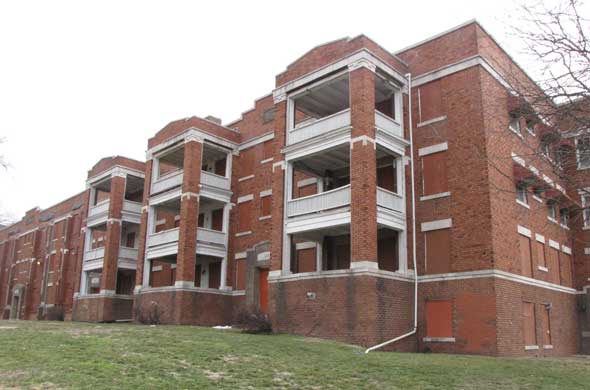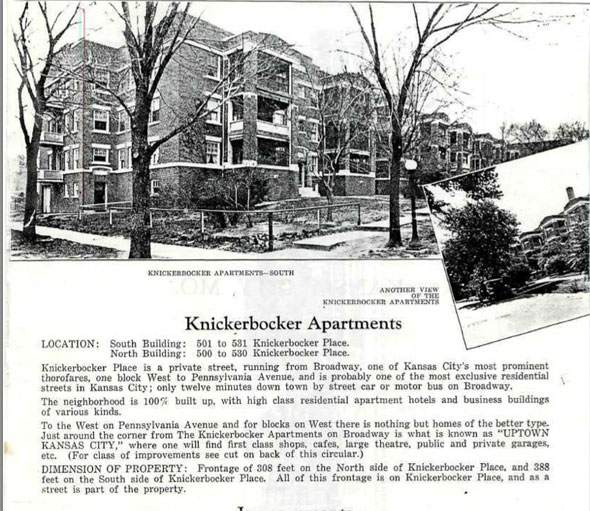
The Knickerbocker Apartments at 510-531 Knickerbocker Place in the Valentine neighborhood is among the ten most endangered buildings in Kansas City, according to the Historic Kansas City Foundation.
Update: Oct. 10, 2017 The Knickerbocker apartments are still vacant.
(The Midtown KC Post is profiling the buildings on the Historic Kansas City Foundation’s Most Endangered List for 2013. More about our series of stories.)
The Knickerbocker Apartments, the half of them that remain, were once part of the largest and most lavish apartment complex in the city.
The actress who became Jean Harlow lived there, as did attorneys, doctors, real estate investors and stockyard owners.
Now the vacant apartments from 501-531 Knickerbocker Place are faded and holes where some porches are gone look like missing teeth.
The block-long apartment building listed on the National Register of Historic Places in 2003 is on the dangerous building list.
The owner is the adjacent Kansas City Life Insurance Company, which demolished the other half of the apartments in 1982.
The documentation for historic status for those that remain tells of what were once the city’s grandest apartments:
In 1900, Kansas City and other cites struggled with growing populations and the need to provide more places to live. Typical apartment buildings then were small, unadorned and narrow to fit on narrow lots, when William H. Collins developed the colonnaded porch style. His buildings were a block long and apartments featured many rooms and columns that flanked deep, multi-decked verandas.
Amid a boom in such structures in 1909, builder and contractor James A. Rose built the Knickerbocker Apartments designed by Leon Grant Middaugh.
They featured extensive living quarters, including 42 of them with three bedrooms, two baths, a living room, a dining room and kitchen with breakfast room. They also had fireplaces and front porches supported by brick piers.
And each apartment came with hot water heat, vacuum cleaners, laundry facilities and private garages. For the first decade, they also had horse drawn taxi and a coachman’s house at the east end of the complex.
They featured a private street in a park-like setting near a street car line.
The Kansas City Social Registrar called apartments there, “a country house in the heart of the Broadway District.”
In 1982, the Valentine Neighborhood Association and the Landmarks Commission of Kansas City fought to save the other Knickerbocker building and lost. Kansas City Life said it needed the space to expand.
Little other Kansas City work by architect Middaugh survives, but he also designed the Westport Library and the Caldwell County Courthouse, both of which are on the national register.




Who’s talking